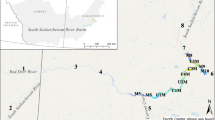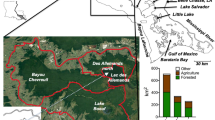Abstract
Lakes and reservoirs provide water for human needs and habitat for aquatic birds. Managers of such waters may ask whether nutrients added by waterfowl degrade water quality. For lakes and reservoirs where primary productivity is limited by phosphorus (P), we developed a procedure that integrates annual P loads from waterfowl and other external sources, applies a nutrient load-response model, and determines whether waterfowl that used the lake or reservoir degraded water quality. Annual P loading by waterfowl can be derived from a figure in this report, using the days per year that each kind spent on any lake or reservoir. In our example, over 6500 Canada geese (Branta canadensis) and 4200 ducks (mostly mallards, Anas platyrhynchos) added 4462 kg of carbon (C), 280 kg of nitrogen (N), and 88 kg of P y−1 to Wintergreen Lake in southwestern Michigan, mostly during their migration. These amounts were 69% of all C, 27% of all N, and 70% of all P that entered the lake from external sources. Loads from all external sources totaled 840 mg P m−2 y−1. Application of a nutrient load-response model to this concentration, the hydraulic load (0.25 m y−1), and the water residence time (9.7 y) of Wintergreen Lake yielded an average annual concentration of total P in the lake of 818 mg m−3 that classified the lake as hypertrophic. This trophic classification agreed with independent measures of primary productivity, chlorophyll-a, total P, total N, and Secchi disk transparency made in Wintergreen Lake. Our procedure showed that waterfowl caused low water quality in Wintergreen Lake.
Similar content being viewed by others
References
Badger, D. D., 1977. Economic potential and management considerations in land application of beef feedlot wastes. In R. E. Loehr (ed.), Land as a Waste Management Alternative. Ann Arbor Science, Ann Arbor, Mich.: 727–742.
Baron, J. & O. P. Bricker, 1987. Hydrologic and chemical flux in Loch Vale watershed, Rocky Mountain National Park. In R. C. Averett & D. M. McKnight (eds), Chemical Quality of Water and the Hydrologic Cycle. Lewis Publ., Chelsea, Mich.: 141–155.
Bellrose, F. C., 1976. Ducks, geese and swans of North America. Stackpole Books, Harrisburg, Pennsylvania, 535 pp.
Bowen, R., 1982. Surface water. John Wiley & Sons. New York, 290 pp.
Brinkhurst, R. O. & B. Walsh, 1967. Rostherne Mere, England, a further instance of guanotrophy. J. Fish. Res. Bd Can. 24: 1299–1309.
Chapra, S. C. & R. P. Canale, 1991. Long-term phenomenological model of phosphorus and oxygen for stratified lakes. Wat. Res. 25: 707–715.
Cooke, G. E., E. B. Welch, S. A. Peterson & P. R. Newroth, 1986. Lake and Reservoir Restoration. Butterworths, Boston, 392 pp.
Ganning, B. & F. Wulff, 1969. The effects of bird droppings on chemical and biological dynamics in brackish water rockpools. Oikos 20: 274–286.
Gremillion, P. T. & R. F. Malone, 1986. Waterfowl waste as a source of nutrient enrichment in two urban hypereutrophic lakes. In Lake and Reservoir Management, Vol. 2. Proceedings of the Fifth Annual Conference and International Symposium on Applied Lake and Watershed Management. November 13–16, 1985. Lake Geneva, Wisconsin. North Am. Lake Mgmt Soc.: 319–322.
Harris, H. J., Jr., J. A. Ladowski & D. J. Worden, 1981. Water-quality problems and management of an urban waterfowl sanctuary. J Wildl. Mgmt 45: 501–507.
Hayes, J. P. & J. W. Caslick, 1984. Nutrient deposition in cattail stands by communally roosting blackbirds and starlings. Am. Midl. Nat. 112: 320–331.
Holden, A. V. & L. A. Caines, 1974. Nutrient chemistry of Loch Leven, Kinross. Proc. Roy. Soc. Edinb. B. 74: 101–121.
Hutchinson, G. E., 1950. Survey of contemporary knowledge of biogechemistry. III The biogeochemistry of vertebrate excretion. Bull. Am. Mus. nat. Hist. 96: 554 pp.
Hutchinson, G. E., 1957. Limnology. I. Geography, Physics, and Chemistry. John Wiley & Sons, New York, 1015 pp.
Johnsgard, P. A., 1965. Handbook of Waterfowl Behavior. Cornell Univ. Press, Ithaca, N.Y., 378 pp.
Johnson, D. H. & M. Owen, 1992. World Waterfowl Populations: Status and Dynamics. In D. R. McCullough & R. H. Barrett (eds), Wildlife 2001: Populations. Elsevier Applied Science, London & New York: 635–652.
Jones, R. A. & G. F. Lee, 1982. Recent advances in assessing impact of phosphorus loads on eutrophication-related water quality. Wat. Res. 16: 503–515.
Kadlec, J. A., 1979. Nitrogen and phosphorus dynamics in inland freshwater wetlands. In T. A. Bookhout (ed.), Waterfowl and Wetlands—An Integrated Review, La Crosse Printing C., La Crosse, Wisconsin, 17–41.
Kear, J., 1963. The agricultural importance of wild goose droppings. The Wildfowl Trust, 14 Annual Rep., 1961–62: 72–77.
Kent, D. C., Z. Al-Shaieb, D. W. Vaden & P. W. Bayley, 1987. Hydrogeological and geochemical aspects of ground and surface water pollution associated with lead and zinc mines in the tri-state mining district. In R. C. Averett & D. M. McKnight (eds), Chemically Quality Water and the Hydrologic Cycle, Lewis Publ., Chelsea, Mich.: 73–88.
Kerekes, J. J., 1982. The application of phosphorus loadtrophic response relationships to reservoirs. Can. Wat. Resour. J. 7: 349–354.
Kerekes, J. J., 1983. Predicting trophic response to phosphorus addition in a Cape Breton Island lake. Proc. N. S. Inst. Sci. 33: 7–18.
Lee, G. F., W. Rast & R. A. Jones, 1978. Eutrophication of water bodies: insights for an age-old problem. Envir. Sci. Technol. 12: 900–908.
Leentvaar, P., 1967. Observations in guanotrophic environments. Hydrobiologia 29: 441–489.
Likens, G. E., F. H. Bormann, R. S. Pierce, J. S. Eaton & N. M. Johnson, 1977. Biogeochemistry of a Forested Ecosystem. Springer-Verlag, New York, 146 pp.
McLandress, M. R. & D. G. Raveling, 1981. Changes in diet and body composition of Canada geese before spring migration. Auk. 98: 65–79.
Manny, B. A., 1971. Interactions of dissolved and particulate nitrogen in lake metabolism. Ph.D. thesis, Michigan State Univ., East Lansing, Mich., 189 pp.
Manny, B. A. & R. W. Owens, 1983. Additions of nutrients and major ions by the atmosphere and tributaries to nearshore waters of northwestern Lake Huron. J. Great Lakes. Res. 9: 403–420.
Manny, B. A., R. G. Wetzel & R. E. Bailey, 1978. Paleolimnological sedimentation of organic carbon, nitrogen, phosphorus, fossil pigments, pollen, and diatoms in a hypereutrophic, hardwater lake: a case history of eutrophication. Pol. Arch. Hydrobiol. 25: 243–267.
Manny, B. A., R. G. Wetzel & W. C. Johnson, 1975. Annual contribution of carbon, nitrogen, and phosphorus by migrant Canada geese to a hardwater lake. Verh. int. Ver. Limnol. 19: 949–951.
NAS (National Academy of Sciences), 1969. Eutrophication: Causes, Consequences, Correctives. Washington, D. C., 661 pp.
NRC (National Research Council), 1984. Nutrient Requirements of Poultry. Ntnl. Acad. Sci. Press, Washington, D.C., 8th edn.
Palazzo, A. J., 1977. Land application of wastewater: forage growth and utilization of applied nitrogen, phosphorus and potassium. In R. E. Loehr (ed.), Land as a Waste Management Alternative. Ann Arbor Science, Ann Arbor, Mich.: 171–180.
Paloumpis, A. A. & W. C. Starrett, 1960. An ecological study of benthic organisms in three Illinois River flood plain lakes. Am. Midl. Nat. 64: 406–435.
Perry, M. C., W. J. Kuenzel, B. K. Williams & J. A. Serafin, 1986. Influence of nutrients on feed intake and condition of captive canvasbacks in winter. J. Wildl. Mngt. 50: 427–434.
Pirnie, M. D., 1935. Michigan Waterfowl Management. Franklin DeKleine Co., Lansing, Mich., 328 pp.
Pirnie, M. D., 1941. The dispersal of wild ducks from the W. K. Kellogg Bird Sanctuary, near Battle Creek, Michigan. Mich. Acad. Sci., Arts & Lett. 26: 251–259.
Portnoy, J. W. & M. A. Soukup, 1990. Gull contributions of phosphorus and nitrogen to a Cape Cod kettle pond. Hydrobiologia 202: 61–69.
Prince, H. H., 1979. Bioenergetics of postbreeding dabbling ducks. In T. A. Bookhout (ed.), Waterfowl and Wetlands—An Integrated Review. La Crosse Printing Co., LaCrosse, Wisconsin: 103–117.
Rast, W., R. A. Jones & G. F. Lee, 1983. Predictive capability of U.S. OECD phosphorus loading-eutrophication response models. J. Wat. Pollut. Cont. Fed. 55: 990–1003.
Ryding, S. & W. Rast (eds), 1989. The control of Eutrophication of Lakes and Reservoirs. UNESCO, Paris, 314 pp.
Shedlock, R. J., N. J. Loiacono & T. E. Imbrigiotta, 1988. Effects of ground water on the hydrochemistry of wetlands at Indiana Dunes, Northwest Indiana. In D. A. Wilcox (ed.), Interdisciplinary Approaches to Freshwater Wetlands Research, Mich. State Univ. Press, East Lansing, Mich.: 37–55.
Sincock, J. L., 1962. Estimating consumption of food by wintering waterfowl populations. 16th Ann. Conf. Southeastern Assoc. Game & Fish Commissioners, October 15–17, 1962, Charleston, South Carolina, Unpubl. Rep., 8 pp.
Taylor, W. H., 1957. Utilization, preference, and nutritional value of wintergreen agricultural crops for goose food. Unpublished M.A. thesis, Virginia Poly. Inst., Blacksburg, Virginia.
USEPA (U. S. Environmental Protection Agency), 1971. Agricultural pollution of the Great Lakes basin. U. S. Government Printing Office, Washington, D.C., 20402. Stock No. 5501–0134, 94 pp.
Vollenweider, R. A., 1975. Input-output models, with special reference to the phosphorus loading concept in limnology. Schweitz Z. Hydrol. 37: 53–84.
Vollenweider, R. A., 1976. Advances in defining critical loading levels for phosphorus in lake eutrophication. Mem. Ist. ital. Idrobiol. 33: 53–83.
Vollenweider, R. A. & J. J. Kerekes, 1981. Background and summary results of the OECD Cooperative Programme on Eutrophication. In Restoration of lakes and inland waters. Int. Symp. on Inland Waters and Lake Restoration. Sept. 8–12, 1980. Portland, Maine. EPA, Washington, D.C., EPA 440/5–81–110: 25–36.
Wetzel, R. G., 1966a. Variarions in productivity of Goose and hypereutrophic Sylvan lakes, Indiana. Invest. Indiana Lakes and Streams 7: 147–184.
Wetzel, R. G., 1966b. Productivity and nutrient relationships in marl lakes of northern Indiana. Verh. int. Ver. Limnol. 16:321–332.
Wetzel, R. G., 1983. Limnology. 2nd edn. W.B. Saunders Co., Philadelphia, 743 pp.
Wetzel, R. G., 1987. Groundwater and nutrient seepage fluxes through subaqueous sediments of a hardwater lake. Abstract, 50th Annual Meeting, Am. Soc. Limnol. Oceanogr., Madison, Wisconsin, June 1987.
Wetzel, R. G. & B. A. Manny, 1978. Postglacial rates of sedimentation, nutrient and fossil pigment deposition in a hardwater marl lake of Michigan. Pol. Arch. Hydrobiol. 25: 453–469.
Wetzel, R. G. & A. Otsuki, 1974. Allochthonous organic carbon of a marl lake. Arch. Hydrobiol. 73: 31–56.
Winter, T. C., 1981. Uncertainties in estimating the water balance of lakes. Wat. Res. Bull. 17: 82–115.
Author information
Authors and Affiliations
Additional information
Contribution 824 of the National Fisheries Research Center-Great Lakes, 1451 Green Road, Ann Arbor, Michigan 48105, U.S.A. and 722 of the Kellogg Biological Station, Michigan State University.
Rights and permissions
About this article
Cite this article
Manny, B.A., Johnson, W.C. & Wetzel, R.G. Nutrient additions by waterfowl to lakes and reservoirs: predicting their effects on productivity and water quality. Hydrobiologia 279, 121–132 (1994). https://doi.org/10.1007/BF00027847
Issue Date:
DOI: https://doi.org/10.1007/BF00027847




